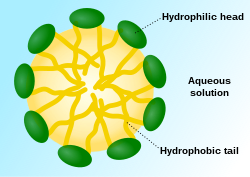Polar bond
In chemistry, a polar bond is a type of covalent bond between two or more dissimilar atoms, in which electrons are shared unequally. A covalent bond is the "strong" kind of bond that makes a molecule.[1]
Electrons are negatively charged. If the two atoms share the electrons equally, then the negative charge is evenly spread out over the entire molecule, balanced out by the positive charges of the protons in the atoms' nuclei. This makes the entire molecule neutral - a non-polar bond, making a non-polar molecule. However, if one of the atoms is particularly greedy for electrons (called electronegativity), then its side of the bond will have more electrons. Therefore, that side of the bond will have a slightly negative charge, and the other side will have a slightly positive charge.[2]
This is important because it turns the bond into an electrical dipole. This dipole acts like a magnet, if other bonds that work as dipoles are nearby, it will react to them.
In some molecules, these polar bonds are lined up with each other. Then the entire molecule is a dipole, and attracts other dipoles. Water does this. You can see in the image that the hydrogen (small and white) is positively charged and the oxygen (big and red) is negatively charged. This picture shows how the little water dipoles line up with each other, in the same way that if you toss a bunch of little magnets into a box, they will line up with each other.[3]
This is one of the most basic and important differences between bonds (and the resulting molecules) in chemistry. This can be easily predicted (because the electronegativity of all the atoms in the periodic table is known). It creates an enormous difference in how the molecules behave.
When the difference in electron negativity between the 2 atoms Is more in covalent bond the more electron negativity, atom acquire partial negativity charge and other atom acqiure partial positive charge.
Polar Bond Media
A water molecule, a commonly used example of polarity. Two charges are present with a negative charge in the middle (red shade), and a positive charge at the ends (blue shade).
A diagram showing the bond dipole moments of boron trifluoride. δ− shows an increase in negative charge and δ+ shows an increase in positive charge. Note that the dipole moments drawn in this diagram represent the shift of the valence electrons as the origin of the charge, which is opposite the direction of the actual electric dipole moment.
The water molecule is made up of oxygen and hydrogen, with respective electronegativities of 3.44 and 2.20. The electronegativity difference polarizes each H–O bond, shifting its electrons towards the oxygen (illustrated by red arrows). These effects add as vectors to make the overall molecule polar.
In methane, the bonds are arranged symmetrically (in a tetrahedral arrangement) so there is no overall dipole.
This amphiphilic molecule has several polar groups (hydrophilic, water-loving) on the right side and a long nonpolar chain (lipophilic, fat-loving) at the left side. This gives it surfactant properties
A micelle – the lipophilic ends of the surfactant molecules dissolve in the oil, while the hydrophilic charged ends remain outside in the water phase, shielding the rest of the hydrophobic micelle. In this way, the small oil droplet becomes water-soluble.







